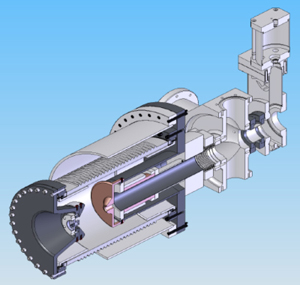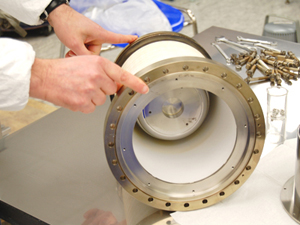The heart of TRIUMF’s ARIEL facility will be the e-linac, a next-generation particle accelerator that will advance isotopes for science and medicine. The e-linac – short for electron linear accelerator – will not only be the first true counterpart of the main cyclotron in terms of power and flexibility, but it will also be the first large-scale device at TRIUMF that focuses on accelerating electrons instead of protons or ions.
Everything for the e-linac starts with the “e-gun”, which is the source of the electrons and the initial steering, shaping, and speeding up of the electrons. In some ways, the e-gun is the counterpart to the ion source for the cyclotron. Its purpose is to accelerate electrons to several hundred thousand electron volts (keV or kiloelectron volts) for insertion into the e-linac cryomodules. TRIUMF’s team of electron pioneers has successfully designed and demonstrated a prototype that reaches 100 keV; the final design goal is 300 keV, which will be built off this initial success. It is difficult to maintain high voltage without a breakdown or arc causing the apparatus to short out, therefore this is a compelling accomplishment!
The electrons are emitted from the surface of a cathode (the source of electrons), which is operated at a temperature of about 1,000 degrees Celsius. With the cathode being at high voltage, the electrons are strongly attracted toward the anode at ground potential. As they shoot toward the anode, they accelerate. Just in front of the cathode, the electrons have to pass through a grid on which a high frequency (RF) field of 650 MHz is applied, causing the beam to become modulated. The electrons come out in small compact packets, which already match the time structure necessary for the acceleration in the high frequency field of the e-linac. The average electron beam current is up to 10 mA, which will correspond to 3 kW at the maximum beam energy of 300 keV from the final e-gun.
After it's successful performance up to the maximum designed beam current a few weeks ago, the 100 keV prototype e-gun is now going to be used for commissioning the injector cryomodule that is currently being constructed in collaboration with India. The device is being disassembled and relocated to the test area in the corner of ISAC-II where the beam tests will be performed. At the same time, the TRIUMF team is working on the 300 keV device.
The TRIUMF team was led by Friedhelm Ames along with Ken Fong, Carl Beard, and others. “It’s quite the milestone as it’s the first step,” said Friedhelm Ames, a pivotal hand in the designing of the e-gun, “Such a scheme of producing a modulated electron beam has been done but not at this high beam power.” Congratulations to the full team for “bringing electrons to TRIUMF!”
This feat is another milestone as the ARIEL project moves into full swing, as TRIUMF celebrated first groundbreaking on the civil construction last week. The 300 keV e-gun will be commissioned next year.
-- Written by Lindsay Davies, Communications Assistant | 
3D Model of the E-gun 
Shot of the ceramic casing, which encompasses the anode and steering coil
|


